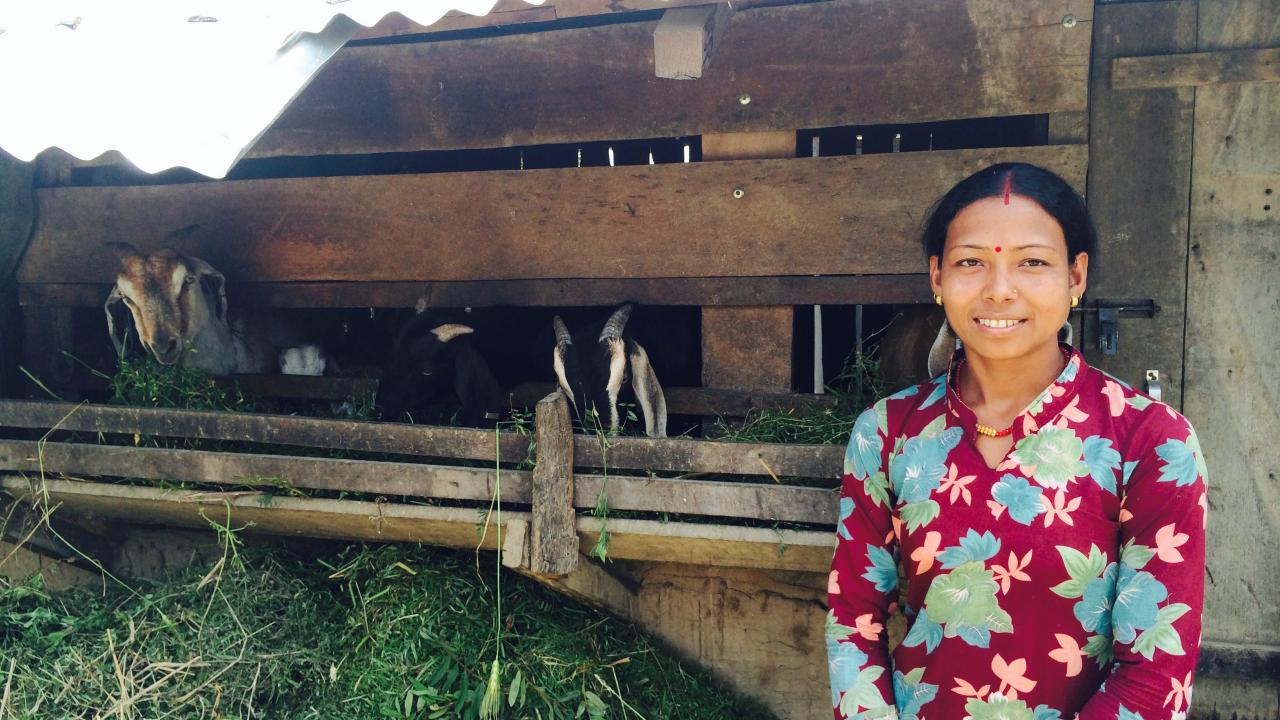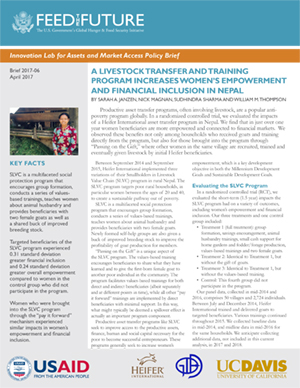
Productive asset transfer programs, often involving livestock, are a popular antipoverty program globally. In a randomized controlled trial, we evaluated the impacts of a Heifer International asset transfer program in Nepal.
We find that in just over one year women beneficiaries are more empowered and connected to financial markets. We observed these benefits not only among households who received goats and training directly from the program, but also for those brought into the program through “Passing on the Gift,” where other women in the same village are recruited, trained and eventually given livestock by initial Heifer beneficiaries.
Key Facts
- SLVC is a multifaceted social protection program that encourages group formation, conducts a series of values-based trainings, teaches women about animal husbandry and provides beneficiaries with two female goats as well as a shared buck of improved breeding stock.
- Targeted beneficiaries of the SLVC program experienced 0.31 standard deviation greater financial inclusion and 0.24 standard deviation greater overall empowerment compared to women in the control group who did not participate in the program.
- Women who were brought into the SLVC program through the “pay it forward” mechanism experienced similar impacts in women’s empowerment and financial inclusion.
 Between September 2014 and September 2015, Heifer International implemented three variations of their Smallholders in Livestock Value Chain (SLVC) program in rural Nepal. The SLVC program targets poor rural households, in particular women between the ages of 20 and 40, to create a sustainable pathway out of poverty.
Between September 2014 and September 2015, Heifer International implemented three variations of their Smallholders in Livestock Value Chain (SLVC) program in rural Nepal. The SLVC program targets poor rural households, in particular women between the ages of 20 and 40, to create a sustainable pathway out of poverty.
SLVC is a multifaceted social protection program that encourages group formation, conducts a series of values-based trainings, teaches women about animal husbandry and provides beneficiaries with two female goats. Newly formed self-help groups are also given a buck of improved breeding stock to improve the profitability of goat production for members.
“Passing on the Gift” is a unique aspect of the SLVC program. The values-based training encourages beneficiaries to share what they have learned and to give the first-born female goat to another poor individual in the community. The program facilitates values-based trainings for both direct and indirect beneficiaries (albeit separately and at different points in time), while all other “pay it forward” trainings are implemented by direct beneficiaries with minimal support. In this way, what might typically be deemed a spillover effect is actually an important program component.
Productive asset transfer programs like SLVC seek to improve access to the productive assets, finance, human and social capital necessary for the poor to become successful entrepreneurs. These programs generally seek to increase women’s empowerment, which is a key development objective in both the Millennium Development Goals and Sustainable Development Goals.
Evaluating the SLVC Program
In a randomized controlled trial (RCT), we evaluated the short-term (1.5 year) impacts the SLVC program had on a variety of outcomes, including women’s empowerment and financial inclusion. Our three treatments and one control group included:
- Treatment 1 (full treatment): group formation, savings encouragement, animal husbandry trainings, small cash support for home gardens and fodder/forage production, values-based trainings and two female goats.
- Treatment 2: Identical to Treatment 1, but without the gift of goats.
- Treatment 3: Identical to Treatment 1, but without the values-based training.
- Control: This fourth group did not participate in the program.
Our panel data, collected in mid-2014 and 2016, comprises 50 villages and 2,724 individuals. Between July and December 2014, Heifer International trained and delivered goats to targeted beneficiaries. Various trainings continued throughout 2015. We collected baseline data in mid-2014, and midline data in mid-2016 for the same households. We anticipate collecting additional data, not included in this current analysis, in 2017 and 2018.
Impact on Targeted Beneficiaries
For women who participated in the SLVC program as targeted beneficiaries, we find that the intervention caused 0.31 standard deviation greater financial inclusion compared to women in the control group who did not participate. Women who participated also experienced greater overall empowerment by 0.24 standard deviation. We observed similar impacts across all three treatment arms for targeted beneficiaries.
To measure empowerment, we employed the Five Domains of Empowerment (5DE) subindex of the Women’s Empowerment in Agriculture Index (WEAI)1 modified to the local context. This index aggregates an empowerment score across production, resources, income, leadership and time.
Looking across the five domains of the WEAI index, we find that SLVC had impacts in three of them. Compared to women in the control group, women who participated in the program are 4.3 percentage points more likely to own productive assets, 4.6 percentage points more likely to have some control over use of income and 15.6 percentage points more likely to belong to a group.
Belonging to a group is easily explained through the program design, as beneficiaries join self-help groups. However, the increases in asset ownership and control over income are not a mechanical result of receiving livestock. Beneficiaries in one of the three treatment arms did not receive livestock and yet we observed a significant impact.
We measured financial inclusion using an aggregate index that considers savings and credit decisions, as well as time preferences. Looking across the various components of the index, we find that SLVC increased the likelihood that women are in a savings group, and also increases the amount women save.
We do not observe changes in income, asset holdings or expenditures for beneficiaries of the program. However, taking into account goat gestational periods and kid growth rates, the timing of livestock transfers has not yet allowed for goat sales. As such, it may be too early to observe income effects.
That we do not observe statistically significant differences in outcomes across treatments suggests either that our analysis could not capture small differences between treatments or that the combination of activities is not critical for increased empowerment or financial inclusion in the short run. It is too early to say if the different program components are important for improving long-run economic outcomes.
The Impact of Paying It Forward
Strikingly, we observe similar effects on women’s empowerment and financial inclusion for women who were brought into the program through the pay-it-forward mechanism. These results are impressive given the relatively short time horizon in which to observe indirect impacts. Most indirect beneficiaries had not yet received livestock, yet, as with targeted beneficiaries, the program increased asset ownership by women, women’s control over earned income and savings.
Notably, we did not find these indirect impacts when the values-based trainings that encourage paying it forward are withheld. This suggests the pay-it-forward encouragement is effective in achieving a broader impact.
Policy Implications
Our findings suggest that women who participate in a multifaceted social protection program that combines trainings with an asset transfer are more empowered and connected to financial markets in the short run. The findings also demonstrate how the encouragement to pay it forward can help achieve a broader impact.
In the coming years, we will measure the strength and persistence of these effects, impacts on income and consumption and the cost effectiveness of the program. Measuring the strength and persistence of effects is crucial to understand the full program impacts. Future data collection will accommodate analyzing the long-term impacts on these economic outcomes.
Sarah A. Janzen is an assistant professor of economics at Montana State University.
Nick Magnan is an assistant professor of agricultural and applied economics at the University of Georgia.
Sudhindra Sharma is executive director of Interdisciplinary Analysts in Nepal.
William M. Thompson is a Ph.D. candidate in agricultural and applied economics at the University of Georgia.
[1] Alkire et al. 2013. “The Women’s Empowerment in Agriculture Index,” World Development.
This report is made possible by the generous support of the American people through the United States Agency for International Development (USAID). The contents are the responsibility of the Feed the Future Innovation Lab for Assets and Market Access at UC Davis and do not necessarily reflect the views of USAID or the United States Government.
